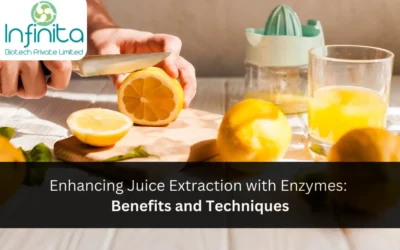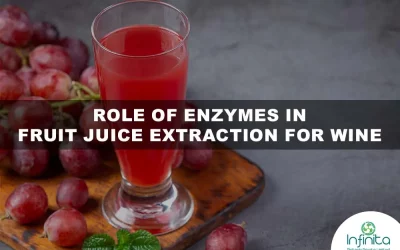In the world of fruit juice extraction, enzymes play a vital role. These biological catalysts are responsible for enhancing both the yield and quality of the juice we enjoy. Understanding how enzymes work and how they can be effectively utilized is crucial for maximizing the potential of fruit juice extraction.
Understanding Enzymes and Their Functions
Enzymes are protein molecules that act as catalysts in biological reactions. They have the remarkable ability to speed up chemical reactions without being consumed in the process. In fruit juice extraction, enzymes break down complex substances, such as pectin and starch, into simpler forms that are more easily extracted. This breakdown process, called hydrolysis, helps to release more juice and improve its overall quality.
Enzymes are incredibly versatile and are involved in a wide range of biological processes beyond fruit juice extraction. For example, in the human body, enzymes play a crucial role in digestion by breaking down food into nutrients that can be absorbed. Without enzymes, essential processes like metabolism and cell repair would be significantly impaired.
The Biological Significance of Enzymes
Enzymes play a vital role in various biological processes, including fruit ripening and decay. During ripening, enzymes break down complex carbohydrates, converting them into simple sugars that contribute to the juice’s sweetness. On the other hand, enzymes are also responsible for the degradation of fruits after they have ripened, leading to spoilage. By understanding the role of enzymes in fruit physiology, we can harness their power to optimize fruit juice extraction.
Furthermore, enzymes are not only limited to fruit-related processes but are also essential in maintaining overall ecosystem balance. In soil, enzymes facilitate the decomposition of organic matter, releasing nutrients that are vital for plant growth. This intricate web of enzymatic activity highlights the interconnectedness of biological systems on both macro and micro scales.
Enzymes in the Food Industry
The food industry has long recognized the potential of enzymes in improving various processes, including fruit juice extraction. Enzymes offer several advantages over traditional methods, such as increased efficiency, reduced processing time, and improved product quality. With these benefits in mind, many juice manufacturers have eagerly adopted enzymatic processes to enhance their production methods.
Moreover, enzymes have revolutionized the food industry by enabling the development of new products and techniques. From cheese-making to brewing beer, enzymes play a key role in enhancing flavors, textures, and nutritional profiles. The precise control and specificity of enzymes have opened up a world of possibilities for food scientists and manufacturers seeking to innovate and meet consumer demands for healthier and more sustainable products.
The Process of Fruit Juice Extraction
Before delving into the specific role of enzymes in fruit juice extraction, let’s explore the overall process involved. Traditionally, juice extraction involved methods such as mechanical pressing, steam extraction, or centrifugation. These methods relied on physical force to extract the juice from the fruit.
When it comes to mechanical pressing, the oldest method of juice extraction, pressure is applied to squeeze the juice out of the fruit. While this method is effective to some extent, it often leaves behind significant amounts of juice trapped in the fruit pulp, resulting in lower yields. On the other hand, steam extraction involves subjecting the fruit to steam, which causes the juice to be released through ruptured cell walls. Although these traditional methods have been widely used for centuries, they do not always offer the best yield or quality of juice.
Traditional Methods of Juice Extraction
Mechanical pressing, the oldest method of juice extraction, utilizes pressure to squeeze the juice out of the fruit. While effective to some extent, this method often left behind significant amounts of juice trapped in the fruit pulp. Similarly, steam extraction involved subjecting the fruit to steam, causing the juice to be released through ruptured cell walls. While these traditional methods were widely used, they did not always offer the best yield or quality.
In contrast to traditional techniques, modern juice extraction methods have revolutionized the industry by overcoming the limitations of their predecessors and offering enhanced results. One such innovative technique involves the use of enzymes to assist in the extraction process. Enzymes play a crucial role in breaking down the structural components of fruits, thereby allowing the juice to be released more easily and efficiently. By utilizing enzymes, juice producers can significantly improve their extraction yields and the overall quality of the juice.
Modern Techniques in Juice Extraction
Modern juice extraction techniques overcome the limitations of traditional methods and offer enhanced results. One such technique involves the use of enzymes to assist in the extraction process. Enzymes break down the structural components of fruits, allowing the juice to be released more easily. Additionally, enzymes can be used in conjunction with other methods, such as pulping or maceration, to further improve extraction efficiency.
The Impact of Enzymes on Juice Extraction
Now that we understand the basics of fruit juice extraction, let’s explore how enzymes can make a significant impact on the process. Enzymes offer two primary advantages: improved yield and enhanced juice quality.
When delving deeper into the world of enzymes and their impact on juice extraction, it’s fascinating to note the intricate mechanisms at play. Enzymes act as biological catalysts, speeding up the breakdown of complex substances within fruits. This acceleration not only expedites the extraction process but also ensures a more thorough extraction, leaving no drop of juice behind.
How Enzymes Improve Yield
Enzymes break down complex substances, such as pectin and starch, into simpler forms that can be more easily extracted. By degrading these structural components, enzymes significantly increase the yield of juice obtained from a given amount of fruit. In addition, enzymes help ensure that every drop of juice is extracted, minimizing waste and maximizing efficiency.
Moreover, enzymes exhibit specificity in their actions, targeting specific compounds within the fruit to optimize the extraction process. This targeted approach not only boosts yield but also maintains the integrity of the juice, preserving its natural flavors and nutritional content.
Enzymes and Juice Quality Enhancement
Enzymes also play a crucial role in enhancing the quality of fruit juice. By breaking down pectin, which is responsible for fruit juice cloudiness, enzymes help produce clear, visually appealing juice. Enzymes can also improve the texture and mouthfeel of the juice, making it smoother and more enjoyable to consume. Furthermore, enzymes aid in the release of aromatic compounds, enhancing the flavor and aroma profile of the juice.
Additionally, the use of enzymes in juice extraction underscores the importance of sustainable practices in food production. By maximizing yield and enhancing quality, enzymes contribute to reducing food waste and promoting efficiency in the fruit processing industry.
Different Types of Enzymes Used in Juice Extraction
Enzymes used in fruit juice extraction can vary depending on the desired outcome and the specific fruit being processed. Two commonly used enzymes in the industry are pectinase and amylase.
When it comes to the world of juice extraction, enzymes play a crucial role in enhancing the process and improving the quality of the final product. In addition to pectinase and amylase, there are other enzymes like cellulase and protease that are sometimes used to further optimize juice extraction.
Pectinase and Its Role in Juice Extraction
Pectinase is an enzyme that specifically targets pectin, a complex carbohydrate found in the cell walls of fruits. By breaking down pectin, pectinase helps to release trapped juice and improve overall extraction efficiency. Additionally, pectinase can be used to clarify the juice, removing any cloudiness caused by pectin particles.
Furthermore, pectinase is known for its ability to enhance the yield of juice extracted from fruits, making it a valuable tool for juice manufacturers looking to maximize their production output. This enzyme’s role in breaking down pectin not only aids in juice extraction but also contributes to the smooth texture and improved flavor of the final product.
The Importance of Amylase in Juice Extraction
Amylase, another essential enzyme, targets starch present in fruits. Starch is a complex carbohydrate that can impede juice extraction by creating a gel-like substance. Amylase breaks down starch into simple sugars, thus allowing for easier juice release. This enzymatic action not only improves extraction efficiency but also contributes to the overall sweetness and flavor profile of the juice.
Moreover, amylase plays a key role in ensuring that the juice extracted from fruits maintains a desirable consistency and mouthfeel. By converting starch into sugars, amylase not only aids in the extraction process but also enhances the sensory experience of consuming the juice, making it more palatable to consumers of all ages.
The Future of Enzyme Use in Juice Extraction
As the fruit juice industry continues to evolve, so too does the use of enzymes in extraction processes. With advancing technology and a growing focus on sustainability, future developments in enzyme technology can be expected.
Potential Developments in Enzyme Technology
Scientists and researchers are continually exploring new ways to optimize enzyme usage in fruit juice extraction. This may involve developing more efficient enzyme formulations or identifying enzymes with specific capabilities that can further enhance extraction results. With ongoing advancements, we can anticipate even greater yields and higher quality juice in the future.
Sustainability and Enzyme Use in Juice Production
Enzymatic processes align well with the growing global focus on sustainability. Compared to traditional extraction methods, enzyme-assisted extraction requires less energy and water and produces less waste. Furthermore, enzymes are biodegradable and pose minimal environmental impact. As sustainability becomes a more significant consideration in the food industry, enzymes will likely continue to play a vital role in fruit juice extraction.
But what exactly are enzymes and how do they work in the juice extraction process? Enzymes are specialized proteins that act as catalysts, speeding up chemical reactions without being consumed in the process. In the case of juice extraction, enzymes break down complex molecules in fruits, such as pectin and cellulose, into simpler forms, making it easier to extract the juice. This enzymatic breakdown not only enhances the yield of juice but also improves its flavor and clarity.
Furthermore, enzymes offer a level of specificity that traditional extraction methods lack. Different enzymes can target specific compounds in fruits, allowing for more precise control over the extraction process. For example, enzymes like pectinase can break down pectin, a substance that can cause cloudiness in juice, resulting in a clearer and more visually appealing final product.
In conclusion, enzymes are indispensable in the process of fruit juice extraction, offering enhanced yield and quality. Understanding the functions of enzymes, their impact on extraction, and the various types used is vital for optimizing juice production. With ongoing research and advancements, the future holds exciting possibilities for enzyme technology, ensuring an even brighter future for fruit juice extraction.





